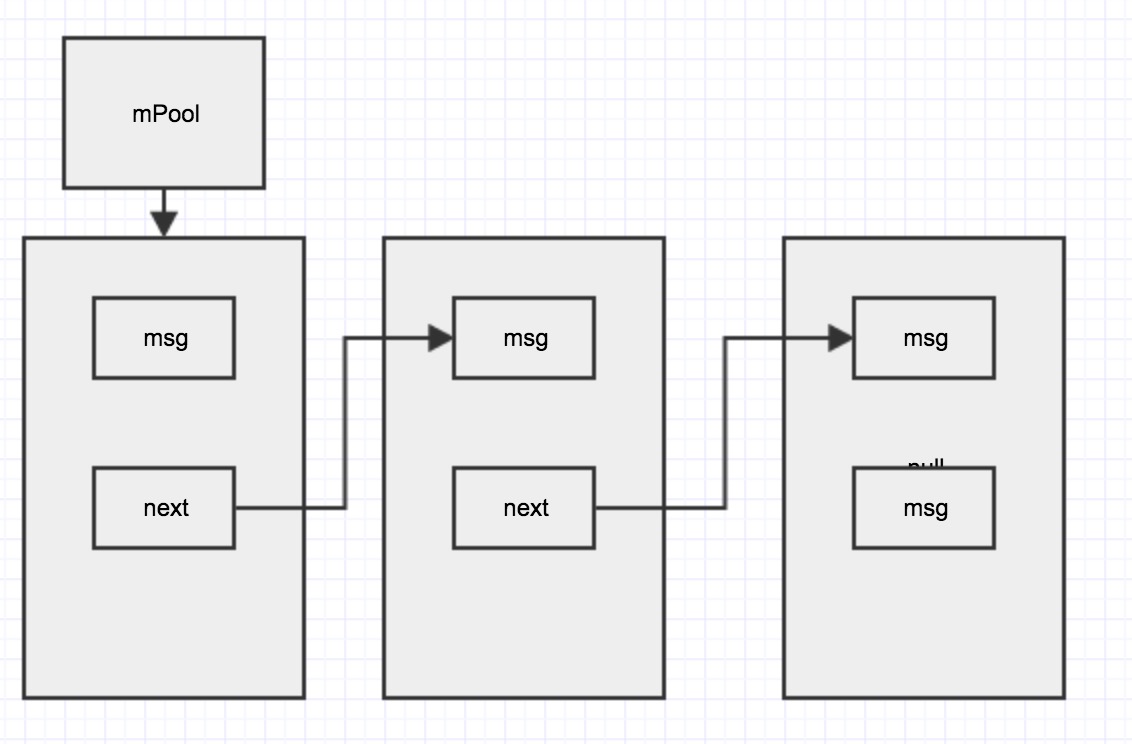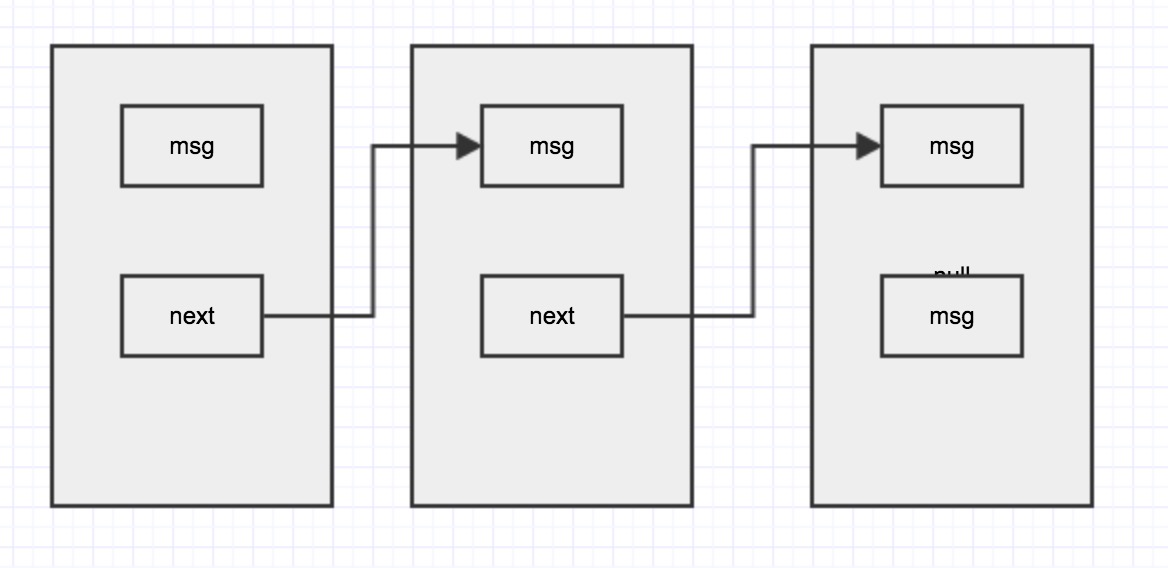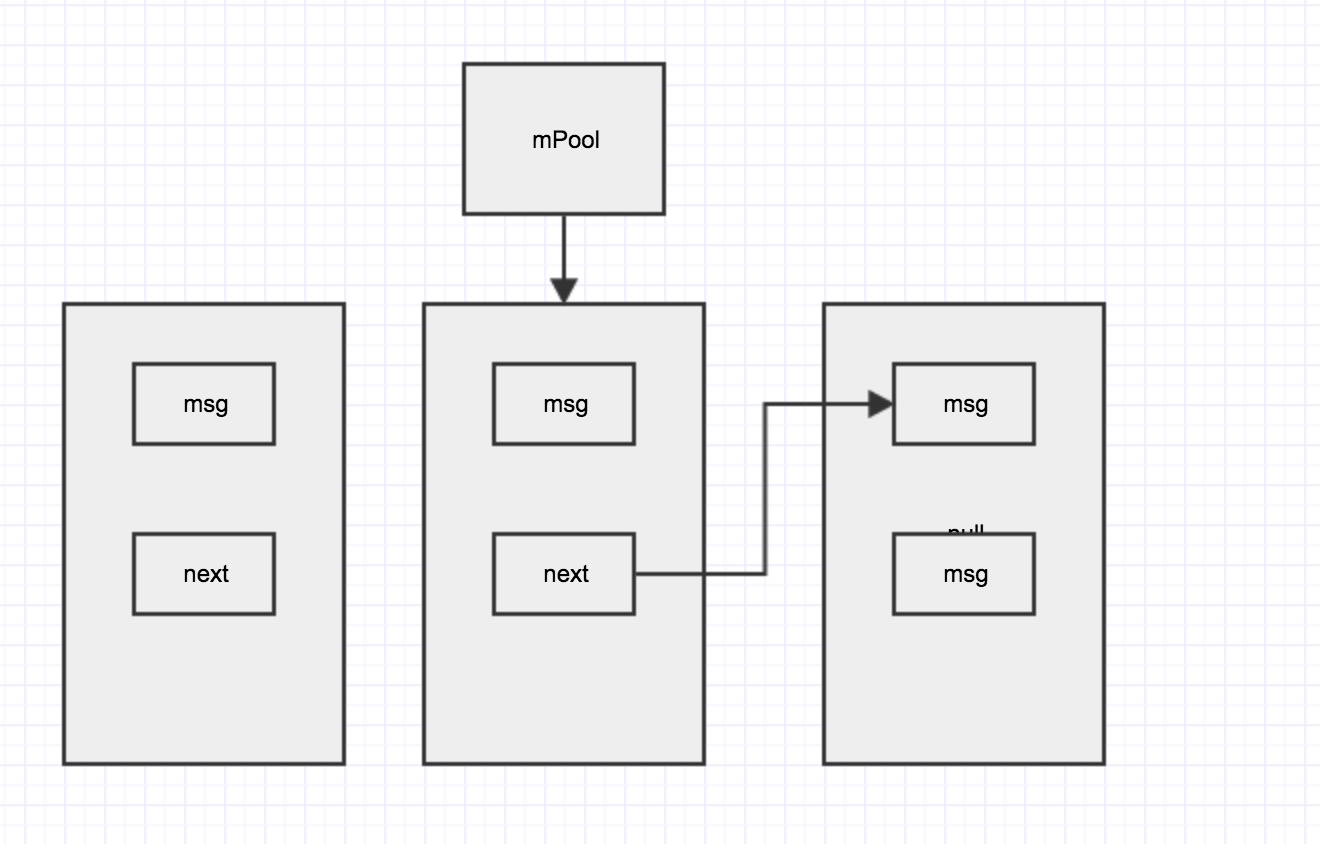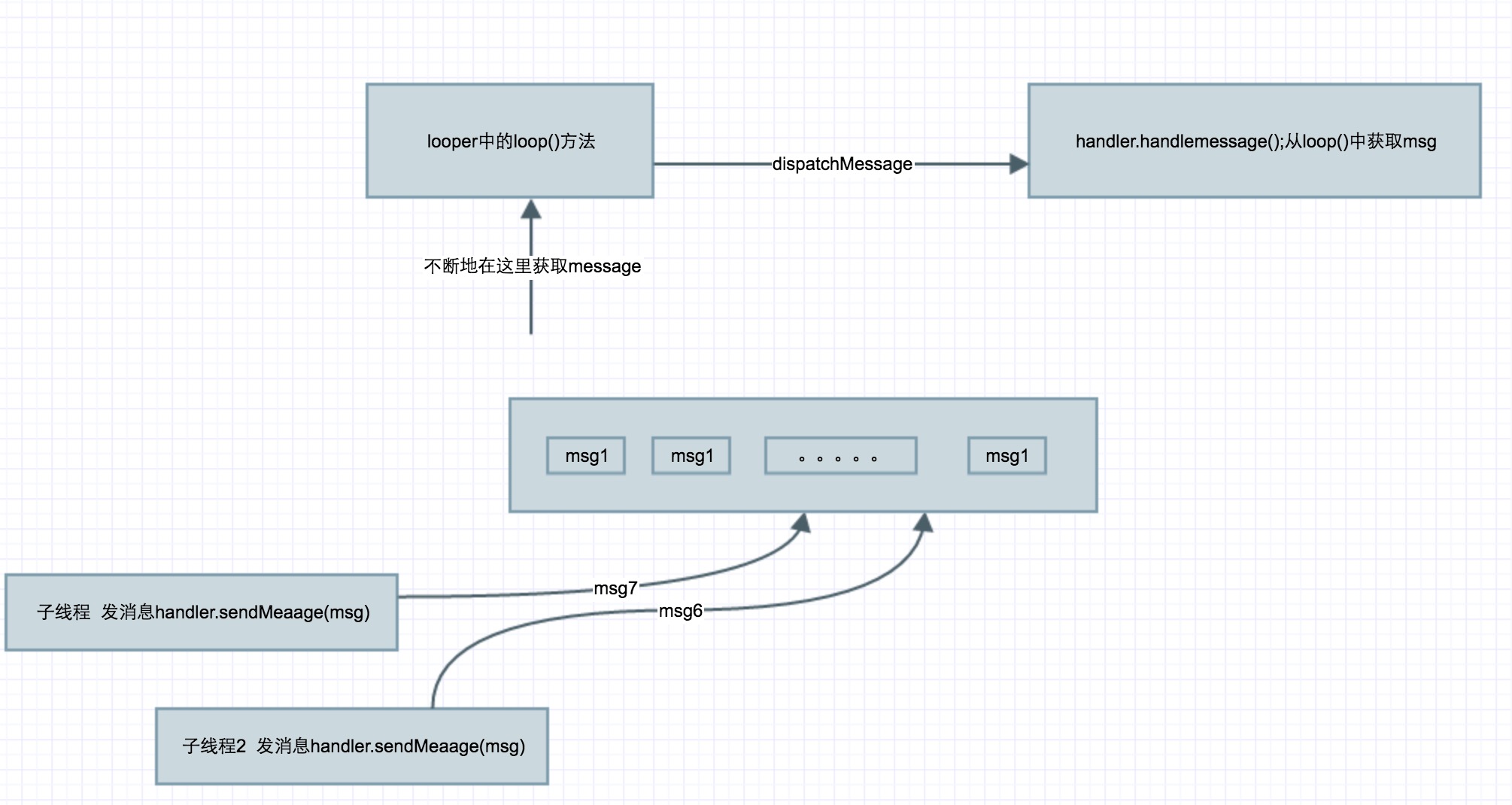说到handler大家都很熟悉,自己也用了很久,再此总结一下 从handler的源码角度看看handler是如何执行的。
涉及到的内容:
- Loop
- Message
- MessageQueue
- ThreadLocal
- Handler
这些东西还是挺多的。那么我们先看一个栗子吧
public class MainActivity extends Activity {
private static final String TAG = "MainActivity";
@Override
protected void onCreate(Bundle savedInstanceState) {
super.onCreate(savedInstanceState);
setContentView(R.layout.activity_main);
findViewById(R.id.btn_http).setOnClickListener(new View.OnClickListener() {
@Override
public void onClick(View v) {
text();
}
});
}
private void text() {
new Thread(new Runnable() {
@Override
public void run() {
Looper.prepare();
Handler handler1 = new Handler() {//为了说明问题的写法
@Override
public void handleMessage(Message msg) {
super.handleMessage(msg);
Log.e(TAG, "handle1: " + msg.what + "-thread1-" + Thread.currentThread().getName());
}
};
Message msg = new Message();
msg.what = 2;
handler1.sendMessage(msg);
handler2.obtainMessage(1).sendToTarget();
handler2.obtainMessage(4).sendToTarget();
Looper.loop();
Log.e(TAG, "loop 执行完毕");
handler2.obtainMessage(3).sendToTarget();
}
}).start();
}
Handler handler2 = new Handler() {//普通写法
@Override
public void handleMessage(Message msg) {
super.handleMessage(msg);
Log.e(TAG, "handle2: " + msg.what + "-thread2-" + Thread.currentThread().getName());
}
};
}
两种写法: 普通写法 和 为了说明问题的写法。 先不管为什么这么写。先执行下代码。你们觉得会怎么执行呢。
结果是这样的
E/MainActivity: handle1: 2-thread1-Thread-18270 :handler1 先发送消息,并且获取到消息。都发生在子线程
E/MainActivity: handle2: 1-thread2-main : handler2 发送消息 获取消息
E/MainActivity: handle2: 4-thread2-main : handler2 发送消息 获取消息但我们的两行代码没有执行
这两行代码没有执行
Log.e(TAG, "loop 执行完毕");
handler2.obtainMessage(3).sendToTarget();一些问题:
- 为什么在子线程里面 执行了 Looper.prepare();和 Looper.loop(); 两行代码 但是在主线程的里面没有写?
- Looper.prepare();和 Looper.loop();是什么意思 他们的放置位置有什么限制么?
- 为什么那两行代码没有执行?
- handler1.sendMessage(msg);和 handler2.obtainMessage(1).sendToTarget();区别是什么?
- 为什么 handlerMessage()可以获取到消息他们的底层是如何实现的呢?
Looper的相关问题
先看一下new Handler();的源码 带我们了解looper;
创建Handler对象时,在构造方法中会获取Looper和MessageQueue的对象
public Handler() {
this(null, false);
}
public Handler(Callback callback, boolean async) {
...省略部分代码..
mLooper = Looper.myLooper();//这里获取一个mLooper
if (mLooper == null) {//如果mLooper为null抛出异常
throw new RuntimeException(
"Can't create handler inside thread that has not called Looper.prepare()");
}
mQueue = mLooper.mQueue;
mCallback = callback;
mAsynchronous = async;
}
看到这里知道了。在使用new Handler()之前必须要有一个mLooper这个对象。不然的话会抛出异常。
接着看
public static @Nullable Looper myLooper() {//这里就返回一个mLooper 了
return sThreadLocal.get();
}
// sThreadLocal.get() will return null unless you've called prepare().
static final ThreadLocal<Looper> sThreadLocal = new ThreadLocal<Looper>(); 这里有个注意的就是ThreadLocal 这个类 就是每次创建一次都会有一个单独的线程出现,每个线程自己做自己的事情 互不干扰。其实呢这个Looper就是为了在该线程中 创建一个messageQueue。然后后面是把handler放到message中。然后再把message放到了messageQueue中。这样 这个handler就可以发送和接受 在该线程中的所有操作了。如果还不理解ThreadLocal的意思。我推荐google一下。张孝祥ThreadLocal。绝对让你理解他的含义。
比如你有一个主线程和10个子线程,现在呢这11个线程里面都new Handler()。就会有11个不同的ThreadLocal。他们之前不顾干扰。然后呢你就需要在这10个子线程里面写都写一遍Looper.prepare()和Looper.loop()。
我们现在已经有了获取looper的方法了。肯定也得有set的方法。
看 Looper.prepare();方法
public static void prepare() {
prepare(true);
}
private static void prepare(boolean quitAllowed) {//这个参数的意思就是这个messagequeue是否可以销毁
if (sThreadLocal.get() != null) {//这里执行了获取ThreadLocal方法。如果已经存在了抛异常。所以 prepare方法在一个线程里只能执行一遍。
throw new RuntimeException("Only one Looper may be created per thread");
}
sThreadLocal.set(new Looper(quitAllowed)); //这里执行了我们想要的set方法。
}
//这个looper方法里面直接new出来了 MessageQueue() 和获取当前线程作为 标示
private Looper(boolean quitAllowed) {
mQueue = new MessageQueue(quitAllowed);
mThread = Thread.currentThread();
}
// True if the message queue can be quit.
private final boolean mQuitAllowed;//这里是判断该messageQueue是否可销毁
MessageQueue(boolean quitAllowed) {
mQuitAllowed = quitAllowed;//赋值
mPtr = nativeInit();
}
Looper和MessageQueue是通过Looper.prepare的时候创建的,在一个线程里面prepare()只能执行一次
从这里我们可以看出来 new Handler();10次。会有10个Threadlocal,会有10个MessageQueue。
到这里我们还有个疑问就是为什么主线程没有写Looper.prepare();
我们新来看ActivityThread这个类。这个类创建主线程。
public static void main(String[] args) {
。。。。
Looper.prepareMainLooper();//有点儿类似prepare的方法
ActivityThread thread = new ActivityThread();
thread.attach(false);
if (sMainThreadHandler == null) {
sMainThreadHandler = thread.getHandler();
}
if (false) {
Looper.myLooper().setMessageLogging(new
LogPrinter(Log.DEBUG, "ActivityThread"));
}
// End of event ActivityThreadMain.
Trace.traceEnd(Trace.TRACE_TAG_ACTIVITY_MANAGER);
Looper.loop();//这里也出现了loop的方法了。
throw new RuntimeException("Main thread loop unexpectedly exited");//loop()方法后面只有一句异常。好像loop不会被停止一样。
}
public static void prepareMainLooper() {
prepare(false);//这里穿的值是false。说明该线程中的messageQueue是不可以被销毁的。
synchronized (Looper.class) {
if (sMainLooper != null) {
throw new IllegalStateException("The main Looper has already been prepared.");
}
sMainLooper = myLooper();//prepare里面执行set方法。这里执行get方法获取Looper
}
}
到这里就明白了为什么 子线程执行 Looper.prepare()方法了。
再来看Looper.loop();
public static void loop() {
final Looper me = myLooper();//获取looper
if (me == null) {
throw new RuntimeException("No Looper; Looper.prepare() wasn't called on this thread.");
}
final MessageQueue queue = me.mQueue;//获取该looper下的queue
。。。。。。
for (;;) {//死循环。我看的源码是api 23的。记得以前是while(true)。为什么捏
Message msg = queue.next(); // might block 可能会阻塞
if (msg == null) {
// No message indicates that the message queue is quitting.
return;
}
。。。。。
msg.target.dispatchMessage(msg);//这个方法很重要
if (logging != null) {
logging.println("<<<<< Finished to " + msg.target + " " + msg.callback);
}
// Make sure that during the course of dispatching the
// identity of the thread wasn't corrupted.
final long newIdent = Binder.clearCallingIdentity();
if (ident != newIdent) {
Log.wtf(TAG, "Thread identity changed from 0x"
+ Long.toHexString(ident) + " to 0x"
+ Long.toHexString(newIdent) + " while dispatching to "
+ msg.target.getClass().getName() + " "
+ msg.callback + " what=" + msg.what);
}
msg.recycleUnchecked();
}
}
这个Looper.loop()方法就是一个死循环不断地从messageQueue中获取msg
Linux的一个进程间通信机制:管道(pipe)。原理:在内存中有一个特殊的文件,这个文件有两个句柄(引用),一个是读取句柄,一个是写入句柄
主线程Looper从消息队列读取消息,当读完所有消息时,进入睡眠,主线程阻塞。子线程往消息队列发送消息,并且往管道文件写数据,主线程即被唤醒,从管道文件读取数据,主线程被唤醒只是为了读取消息,当消息读取完毕,再次睡眠
这里就是到了我们上面说的两行代码 没有执行的原因是因为loop()是死循环。后面的代码不会执行了
我们发现了这里有一个
/**
* Subclasses must implement this to receive messages.
*/
public void handleMessage(Message msg) {
}
/**
* Handle system messages here.
*/
public void dispatchMessage(Message msg) {
if (msg.callback != null) {// 第一优先Runnable对象
handleCallback(msg);
} else {
if (mCallback != null) {// 第二优先Callback对象
if (mCallback.handleMessage(msg)) {
return;
}
}
handleMessage(msg);
}
}
到这里呢。我们就理解了。
Handler handler1 = new Handler() {
@Override
public void handleMessage(Message msg) {
super.handleMessage(msg);
}
};这里其实每次就是重写了一个handlermessage()的方法。来更新我们的线程。
sendMessage()和obtainmessage()
handler发消息有两类方法:sendMessage()和obtainmessage() 其他的什么延迟啊。
sendMessage()方法
所有sendMessage()类的方法都会执行到这里
public boolean sendMessageAtTime(Message msg, long uptimeMillis) {
MessageQueue queue = mQueue;
if (queue == null) {
RuntimeException e = new RuntimeException(
this + " sendMessageAtTime() called with no mQueue");
Log.w("Looper", e.getMessage(), e);
return false;
}
return enqueueMessage(queue, msg, uptimeMillis);
}
private boolean enqueueMessage(MessageQueue queue, Message msg, long uptimeMillis) {
msg.target = this;
if (mAsynchronous) {
msg.setAsynchronous(true);
}
return queue.enqueueMessage(msg, uptimeMillis);//往messageQueue里面插入msg。
}这个Message呢是类似于链表的写法。(觉得算法终于有用了)
什么事链表捏
就是这样。msg不断地只想下一个msg。
boolean enqueueMessage(Message msg, long when) {
。。
synchronized (this) {
。。。
//对消息的重新排序,通过判断消息队列里是否有消息以及消息的时间对比
msg.when = when;
Message p = mMessages;//获取msg
boolean needWake;
if (p == null || when == 0 || when < p.when) {
// 如果消息队列中没有消息,或者当前消息的时候比队列中的消息的时间小,则让当前消息成为队列中的第一条消息
// New head, wake up the event queue if blocked.
msg.next = p;
mMessages = msg;
needWake = mBlocked;
} else {
// 代码能进入到这里说明消息队列中有消息,且队列中的消息时间比当前消息时间小,说明当前消息不能做为队列中的第一条消息
// Inserted within the middle of the queue. Usually we don't have to wake
// up the event queue unless there is a barrier at the head of the queue
// and the message is the earliest asynchronous message in the queue.
needWake = mBlocked && p.target == null && msg.isAsynchronous();
// 当前消息要插入到这个prev消息的后面
Message prev;
// 这个死循环用于找出当前消息(msg)应该插入到消息列表中的哪个消息的后面(应该插入到prev这条消息的后面)
for (;;) {
prev = p;
p = p.next;
if (p == null || when < p.when) {
break;
}
if (needWake && p.isAsynchronous()) {
needWake = false;
}
}
msg.next = p; // invariant: p == prev.next
prev.next = msg;
}
// We can assume mPtr != 0 because mQuitting is false.
if (needWake) { //唤醒主线程
nativeWake(mPtr);
}
}
return true;
}
再看一下obtainmessage();
public static Message obtain() {
synchronized (sPoolSync) {
if (sPool != null) {
Message m = sPool;
sPool = m.next;
m.next = null;
m.flags = 0; // clear in-use flag
sPoolSize--;
return m;
}
}
return new Message();//消息池里面没有消息就new 一个新的消息 所有的消息链表在messageQueue中
}
这个呢就是链表的形式,把消息池里的第一条数据取出来,然后把第二条数据变为第一条。这样循环的取数据

一个循环之后呢
然后都会执行sendToTarget();把消息发出去
public void sendToTarget() {
target.sendMessage(this);这样就是sendMessage()一样啦。
}
可以看到obtainmessage()这样呢就减少了message的创建。
总结
new Handler的时候Handler就已经拿到了线程的Looper 。MessagQueue
handler发送消息:
把Handler保存到Message里。
把Message保存到messageQueue里。
ActivityThread.java主线程入口类
在main()方法中存入了Looper.prepareMainLooper();(这里已经创建了Looper,messagequeue)
然后不断地执行获取消息的方法:Looper.loop();去出message,然后调用handler的dispatchMessage(msg);
一张图解决所有问题
尊重原创http://blog.csdn.net/wanghao200906/article/details/51355018
























 1800
1800











 被折叠的 条评论
为什么被折叠?
被折叠的 条评论
为什么被折叠?








